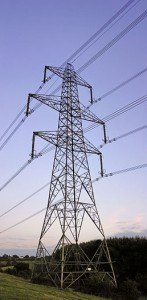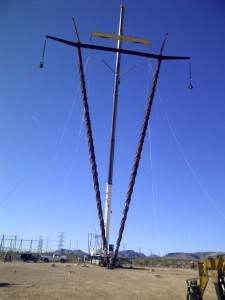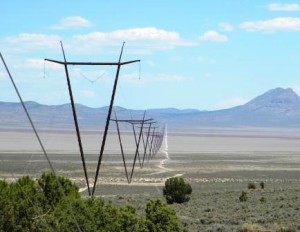140-foot-tall towers designed to have minimal environmental impact had maximum impact when they crashed to the ground in the desert near Las Vegas. Despite extraordinary precautions to protect creatures as small as the desert tortoise and the sage grouse, the construction of a 435-mile electrical transmission line appeared as doomed for failure on a gigantic scale. Designed to carry electricity generated by wind power, ironically the towers themselves were destroyed by wind.
The problem was caused by something called “vortex shredding:” the tendency for tall, thin towers to oscillate perpendicularly to the direction of the wind. The vibration can be violent enough to crack and topple otherwise strong steel members.
We are all familiar with the steel lattice transmission towers we see traversing the country.

Considered by some to be eye pollution, these towers are expensive to erect, have a large footprint, and have a negative environmental impact on the flora and fauna.
But look at this new “V” design below. With an infinitesimal footprint, virtually nothing in the environs was to be disturbed. The “V” design is less expensive to build and erect, is less unattractive to the eye, and is made of weathering steel which will cut down on maintenance. The simpler design also prevents predators from perching on transmission towers and swooping down to attack the desert tortoise and the sage grouse, both protected species. The horizontal members where the birds might perch have a thin steel sheet that the birds don’t like: they have trouble balancing on the sharp edge.

So…what to do with these towers given that they have a tendency to collapse? Hundreds of these towers had been manufactured; dozens had been transported to a staging area and then set at half-mile intervals for installation. Crews had been mobilized, but all work had to come to a halt.
The engineers huddled, scratched their heads, and turned to an old solution: helical strakes. Flat bar rolled helically at a pitch 5 to 6 times the diameter of the cylinder and attached to towers perpendicular to the surface of the tower. These spirals break up and “confuse” the wind while damping the side-to-side vibration. (If you look around cities with any industry, you can probably see similar strakes on smokestacks.)
A mockup of a tower with helical strakes was manufactured and sent to Texas Tech University for wind-tunnel testing. While everyone was waiting anxiously, Chicago Metal Rolled Products began to develop the technology to produce helical strakes efficiently, quickly, and with tight tolerances. Should the project be approved, the company would have to crank out some 67,000 strakes in short order to meet the schedule in Nevada.
The good news came from Texas that the strakes would solve the tower vibration problem. Chicago Metal finalized its contract with the electric companies including the delivery schedule, shipping methods, marking methods, and quality control. Chicago Metal accelerated its research and development to get the job done. Reconfiguring one section of its 100,000 sq. ft. facility, new manufacturing cells were dedicated to this production. As expected, the rate of production was deliberately initially slow to prove out the process and guarantee quality from the first parts. Thereafter, productivity ramped up significantly so that delivery schedules could easily be met.
There were a total of 765 towers of heights varying from 95ft to 145ft tall. The towers are tapered so the helical strakes supplied for each tower necessarily have varying diameters. (The length of each strake was approximately 8ft long.) Consequently, the particular strakes to be provided for a given tower were “kitted” in a single crate to be delivered right to the point of use–the tower in the field.
The kitting proved to be one of the biggest challenges in production and staging especially as production ramped up. Concerns such as clear marking, tensile strength of banding, crate dimensions and other packing concerns had to be addressed on the fly–all to ensure that the kits were easy to manufacture and, more importantly, easy for the welders in the field to work with.
After the first shipments of strakes were delivered to the site, representatives of the various companies met in the desert to test out the best way to attach the strakes to the towers and to gain information on the time it would take to finish one tower. Concerns included certifying the welding process, fitting up the strakes to the tapered tubes, and ensuring quality welds.
The strakes were to be attached to the tube by means of a 2 x 2 x 1/4 angle 2in long which was to act as a connection between the strake and tube. Various sequences were tried; the best solution was to tack weld the strake to the tube and then to weld the angle to the tube and strake as a reinforcing connector. These clips were included in the kits for each tower.
From initial contact, Chicago Metal worked with the electric companies for over a year on test parts and tooling before final production began. Chicago Metal completed its portion of the project and delivered all 67,000 strakes within a 6 month period, months ahead of schedule. (Put end-to-end, these strakes would stretch 100 miles.) The transmission line will provide opportunities to convey electricity from alternative energy sources – including wind – as they are developed in Nevada.
The project manager commented on Chicago Metal’s performance: “I want to thank CMRP for performing as you promised. You are ahead of schedule and the strakes are fitting great. In addition, I appreciate that your invoices are accurate and per the contract. Please thank you team.”








